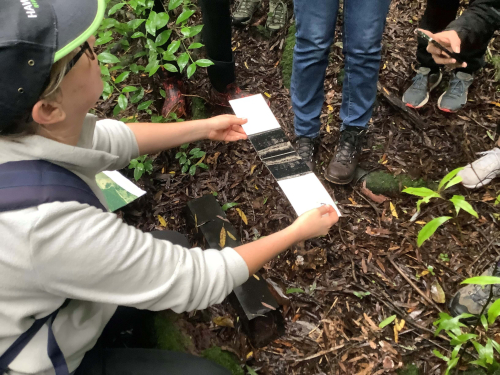
Eastern Institute of Technology (EIT) students and the environment are benefitting from a hands-on learning experience based at Mohi Bush, Maraetōtara. Pest control activities in the bush include monitoring, trapping, and baiting, which are now part of the learning curriculum. Students are able to see outcome of their efforts with decreasing pest numbers.
The project started in 2023 when EIT Tutor Chris Thorman saw an opportunity for students in his Environmental Management class to complete a real-world conservation project that taught environmental sampling techniques, data analysis, and report writing skills. He, and Hawke’s Bay Regional Council colleague Natalie de Burgh, devised the project where students would monitor pest species in the bush both before and after setting baits and traps. Learning outcomes include understanding:
Students also get to use the TrapNZ app to navigate themselves through the bush and record results. Funding from Biodiversity Hawke’s Bay’s Environmental Enhancement Contestable Fund (EECF; funded through HBRC) covered the cost of tracking cards, baits, lures, and other consumables.
The project’s wide variety of potential learning experiences has been enabled by EIT tutor, Belinda Stovell and her Outdoor Education students who have joined their Environmental Management counterparts in managing pest species. By being involved in the project, students can learn navigation and other bush skills relevant to active roles in the outdoors. Regardless of their programme, each student is assigned a series of tracking tunnels within the bush and are responsible for monitoring the pest numbers four times a year to detect changes over time. Traps and bait stations are set up and maintained to actively reduce rodent numbers. The students’ efforts are being rewarded: data collected during the latter months of 2023 have shown a decrease in rat numbers, and continuation of the project in 2024 will hopefully further reduce the rat population.
Mohi Bush is an important forest reserve that hosts a range of native species including populations of rifleman (tītipounamu), New Zealand robin (toutouwai), green geckos and rare native plants. The reserve was part of the Cape to City project, when trapping and baiting infrastructure was deployed to combat mammalian pests (particularly rats and mice). After the project ended, the bush had been largely left to its own devices for around four years. Rat numbers, in particular, increased markedly after Cyclone Gabrielle.
“The project is a great experience for the students”, Chris Thorman says, noting that the first visit to the bush early in the academic year is a valuable team building event for his class. Many students have little experience of the New Zealand outdoors, so this introduction is key to building their confidence in the environment. Furthermore, Chris notes that the EECF funding has been “absolutely fundamental to providing this learning opportunity”, enabling EIT to offer students field work experiences during a period when the Polytech sector is under considerable financial strain. Feedback from students has been very positive and their assessment reports have been of high academic quality.
The Mohi Bush project is a valued opportunity for EIT and HBRC to work together. Natalie and her colleague Nathan Alexander are guest tutors during the programme, adding specialist expertise that compliments EIT staff. It’s a relationship that Chris hopes will continue into the future. “The project allows us to demonstrate to the students all the Learning Outcomes of the course while taking part in a worthwhile predator control program. We hope to continue this valuable partnership for many years to come.”
Dr Belinda Sleight - Community Facilitator, Biodiversity HB

26 February 2024
Disclaimers and Copyright
While every endeavour has been taken by the Hawke's Bay Regional Council to ensure that the information on this website is
accurate and up to date, Hawke's Bay Regional Council shall not be liable for any loss suffered through the use, directly or indirectly, of information on this website. Information contained has been assembled in good faith.
Some of the information available in this site is from the New Zealand Public domain and supplied by relevant
government agencies. Hawke's Bay Regional Council cannot accept any liability for its accuracy or content.
Portions of the information and material on this site, including data, pages, documents, online
graphics and images are protected by copyright, unless specifically notified to the contrary. Externally sourced
information or material is copyright to the respective provider.
© Hawke's Bay Regional Council - www.biodiversityhb.org / 027 231 9367 / info@biodiversityhb.nz